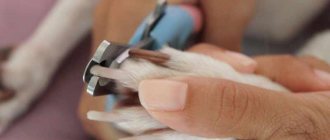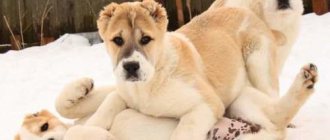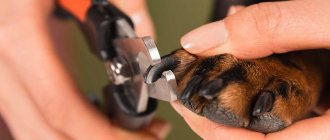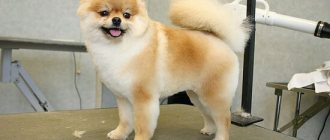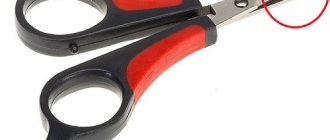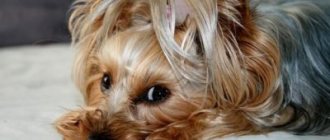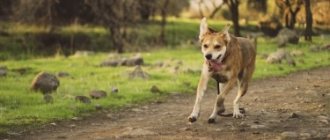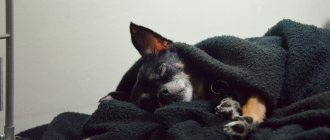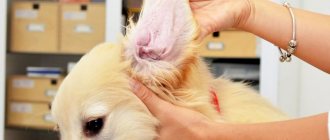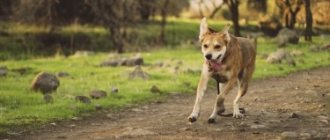A Spitz needs care not only for its luxurious coat, eyes, teeth, but also for its claws. Groomers recommend trimming them every two weeks. Every owner must know how to trim a Spitz's nails correctly.
Anatomy of a dog's claws
Before you start trimming nails, you need to know the structure of a dog's nail.
A dog's claw has one of the following shapes:
- Curved, cat-like, with a sharp edge.
- Arched, slightly curved inward.
- Straight or hare.
Straight claws are usually characteristic of small toy dogs.
But, regardless of the shape of the claw, its internal structure is the same in all dogs:
- The outer shell is called the keratin sheath and is the visible part of the claw. The keratin sheath is constantly growing and it is this that needs to be trimmed.
- The inner part is the claw bed. A blood vessel passes through the bed, so you need to cut the ends very carefully so as not to touch the blood vessel and nerve endings.
The blood vessel becomes longer or shorter depending on how often the claws are cut: the more often, the deeper the vessel goes. Subsequent haircutting procedures are much easier and safer.
Normally, a dog's claw should not touch the floor by about 2-8 mm . Anything longer causes discomfort for the pet and can cause various diseases of the claws or joints.
If the dog is light-colored, then the claw will most often be light-colored and the blood vessel can be seen. In this case, pruning is convenient and safe - the cut border is immediately visible. If the claw is dark and the blood vessel is not visible, you need to trim it carefully and a little at a time so as not to damage the very sensitive tissue and cause bleeding.
Possible problems and solutions
You may encounter resistance from the dog, because this procedure is quite unpleasant for him. Calm your baby to prevent him from getting injured.
- Spitz dogs have dark claws, which makes it difficult to see the beginning of the pulp and correctly measure the distance to it. Therefore, unexpected situations may arise.
- If your Pomeranian jerks excessively and does not allow his nails to be trimmed, wrap him in a swaddle and secure him on your lap.
- When you are confident that you are doing everything correctly, but the animal begins to whine (even when you did not touch the nail bed), most likely he is highly sensitive. Use Lidocaine solution as a pre-treatment before the procedure.
- If the claws are very hard and the nail clipper cannot do the job, cut off the entire length with a regular nail file.
This is interesting! Types of Spitz and their character.
Before performing the procedure yourself, go to an appointment with a veterinarian and see what actions the specialist does and in what sequence.
Items needed for nail care
If the owner is confident in his abilities and is ready to carry out the nail trimming procedure on his own, you need to purchase some tools - clipping scissors. Such tools are called “claw clippers” and come in two types:
- “Secateurs” type - similar to ordinary scissors, but differ in a strong, preferably rubberized, handle and the structure of the blades: one of the blades of the nail cutter is semicircular.
- "Guillotine" . There is only one blade in such a claw cutter - in the form of a lever that cuts off the claw like a guillotine.
Both the guillotine and the pruning shears are different depending on the size of the dog - obviously, a tool designed for a Yorkshire Terrier will fall apart at the very first claw of a German Shepherd. As for the guillotine, depending on the size of the dog and, accordingly, the size of the claw, the diameter of the hole for the claw differs.
Which tool to choose depends on the desire of the dog owner - the one that is more convenient to work with and hold in the hand. But there are several criteria that unite both types:
- The material of the instrument must be brass or steel, otherwise the blades will quickly rust and can cause infection in the claw during the procedure.
- The fastening must be strong; this criterion is especially important for owners of large dogs and dogs whose nail plate is very strong.
- The handles of the nail cutter should be rubberized so that the tool fits comfortably in the hand and the procedure can be completed faster.
In addition to the nail clipper itself, you will also need a file - preferably an electric one; with such a file you can quickly process the cut of the claw, but you can also use an ordinary one.
In addition to devices for carrying out the procedure, you should always keep on hand means to stop bleeding if a vessel inside the claw is nevertheless touched.
How to cut a dog's nails
Even if you have taken courses in manicure, pedicure and nail extensions, you still need to read the information below before trimming your dog’s nails. After all, the structure of the claw is not at all the same as the structure of the human nail, which is why you need to use other tools and techniques.
Special tools
To properly trim your dog's nails, you will need special tools - nail clippers. They come in two types:
- Scissors with sickle blades;
- Guillotines (a kind of wire cutters).
Typically, guillotines are used to trim the nails of small and medium-sized dogs, while nail clippers-scissors will also work well on the tough nails of large dogs. You cannot use regular or manicure scissors (human scissors) as they will separate the claw.
Instructions and tips for trimming nails
Before you start pruning, we recommend preparing styptic powder and a treat, just in case. The first is useful if you cut the claw too short, the second is to distract the pet’s attention and reward for patience.
- The first step is determining where to make the cut. To do this, we find the living part (it contains nerve endings and a blood vessel), in light-colored claws it is a reddish or pink tube that runs down the center of the claw. The cut location will be below it, it is better to take the distance with a margin (the living part may go a little further than it seems).
- Cut the claw at the very tip, where it is curved (the main part is relatively straight). Some nail clippers cut higher than you expect, so you need to play it safe. After all, it’s never too late to cut the hair, but if the cut is too high, blood will flow and it will hurt your pet.
- After trimming the nails, you can sharpen them with a nail file so that there are no uneven edges.
Make the cut at the same angle as in the image above. There is no need to try to cut the claw to the desired length the first time; it is better to trim it gradually, starting from the very tip. This way you will significantly reduce the likelihood of cutting your dog’s nail until it bleeds.
Don't forget about the rudimentary claw located on the inside of the paw (just above the front paws). It often grows faster than others because it comes into contact with the ground less often and, accordingly, wears off less.
To identify the living part in a dark claw, you can use a flashlight. When enlightened, on the other hand, it will be noticeable where the pulp ends and you will approximately get an idea of what height you should not reach when cutting.
Video: how to trim a dog's claws
Be sure to watch the video above where “Sophie the Talking Chihahuahu” explains very well and shows how to trim a small dog’s nails.
The process is similar for the Toy Terrier, Spitz, Chihuahua, Yorkie, and for large breeds of dogs (Rottweiler, Labrador, Shepherd).
Video: veterinarian about the need to trim nails
And in this video, a veterinarian explains why it is necessary to cut a dog’s nails, and how to do it correctly if they are very overgrown. Be sure to look at it to avoid injury to the claw with pulp when pruning.
Step-by-step instructions for trimming nails at home
So, the instruments have been purchased, drugs to stop possible bleeding are at hand, a treat for a calm procedure, too, where to start the manipulation?
If the procedure is being carried out for the first time and the dog owner is not confident in trimming the nails correctly, it is better to first contact a veterinary clinic. The veterinarian will show you how to properly hold the tool and trim the claw.
Preparation
Before the grooming procedure, the dog must be walked and fed. It is advisable, especially with a nervous dog, that the walk is good and the dog is tired.
The nail trimming procedure should be carried out when the dog is in a calm state and in a familiar environment.
During the manipulation, you need to talk to the dog and calm it down so that it does not get nervous and accidentally harm itself by pulling its paw. If the dog categorically refuses to give a paw, you need to gradually accustom him to the procedure: stroke the dog’s paw while talking and, if the dog does not remove his paw from under his hand, treat him with a treat. Gradually you need to take the paw in your hand, stroke it, and touch the fingers separately.
Many dogs are very sensitive to touch between the toes - there are nerve endings there and the dog may be ticklish and instinctively pull the paw out.
Of course, it is best to accustom one to cosmetic procedures from puppyhood - the puppy perceives all manipulations much calmer and, as an adult, accepts all procedures calmly.
Nail trimming
Taking the dog's paw in your hand, so that it is comfortable for both the dog and the owner, you need to carefully move one finger away without squeezing it, so as not to cause pain to the dog.
The claw should be cut at a 45 degree angle to the border of the blood vessel . If the vessel is not visible, then you need to trim the claw a little at a time, gradually moving upward. You need to trim dark claws about half a centimeter at a time, be sure to inspect the cut - if the tip of the claw is wet or has stopped peeling, then you need to stop trimming. If the claw continues to peel a little, then the vessel is deeper and you can continue to trim the claws or file them.
Each finger is processed this way. And you definitely need to remember to treat the rudimentary 5th toe - when walking it is not used in any way and does not wear down, which is why it is usually longer than the rest. If you leave this claw, it can grow in or break off, accidentally touching an object. Breaking off a nail is very painful for a dog and can lead to bleeding and infection of the wound.
It is better to start treating claws from the front paws, moving gradually from claw to claw. Every time the dog behaves calmly and does not pull out its paw, after each finger, it is necessary to praise and treat the pet with a treat - so that the procedure brings only positive impressions to the dog.
Treatment and prevention of wounds
If, however, during trimming the claws a vessel was touched and bleeding began, you need to quickly stop the bleeding.
- You can buy a special hemostatic powder at the veterinary pharmacy, which must be rubbed in until the bleeding stops.
- But you can get by with the usual means: treat the bleeding wound with hydrogen peroxide. Peroxide quickly and effectively stops bleeding.
- After stopping the bleeding, the wound is treated with an antiseptic - a chlorhexidine solution is perfect for this purpose: it can wash the wound and get rid of possible infection.
- If the bleeding does not stop within 30 minutes or more, the wound may be deeper or the dog has health problems - in this case, you should urgently take the dog to a veterinarian.
- Once the bleeding has stopped and the wound has been cleaned, a bandage can be applied. It is advisable to put any wound-healing ointment under the bandage - for example, mekol (or levomekol). To prevent your dog from tearing the bandage and licking the wound, you can wear a special veterinary cap.
The severity of the wound can be shown by the dog’s behavior - if the dog does not stand on its paw at all, then it is worth showing it to a specialist: perhaps treating the damaged claw alone is not enough and veterinary help is needed.
Cat Nail Trimming Tools
Before telling you what tools are used to trim a cat’s claws, it is worth warning that they are not used under any circumstances: ordinary scissors are not suitable, however, neither is the housewife’s favorite manicure set. As an exception, sometimes only a nail file is used for polishing nails.
Specialized pet stores are not uncommon, as are veterinary pharmacies, so you can safely purchase a variety of cat care supplies there. In such places they will always advise and select convenient tools and even give advice on how to trim a cat’s claws .
What is used for cat manicure:
- a nail clipper, which must be sharp. Dull blades often hit sensitive areas and cause pain. Nail clippers are divided into sickle and guillotine clippers;
- a blood stopper or antiseptic. These medications may come in handy if you hit a sensitive part. Iodine or hydrogen peroxide work great. After cauterization, the wound is sprinkled with baby talcum powder;
- blisters - special scissors that look like manicure scissors, but are designed to resemble a cat’s claw;
- file for polishing;
- Long-haired cat breeds, such as Persians, will need a hair clipper, as fur on the paws interferes with the claw trimming process. If the cat is shy or the sound of the running machine irritates him, then the fur from the paws is cut off by hand using scissors;
- alcohol to disinfect accessories. All nail trimming tools must be sanitized before the procedure begins.
Tips and warnings
Nail trimming is a very important procedure. If you do not take care of the nails, they will grow endlessly and cause inconvenience to both the dog and the owners.
Not every dog can grind its claws down during a walk - decorative breeds are most often found outside on a surface that is far from being where their claws are worn down naturally. Of course, overgrown nails are not only a problem for toy breeds; large or medium-sized dog breeds can also suffer from overly long nails.
Untimely nail trimming can cause your dog to:
- Violation of joint development;
- Cause irreversible changes in the position of the paw;
- Change in gait;
- Cause constant pain.
A gradually growing claw can grow inward, cause inflammation and infection of the wound, and this threatens the pet’s life. An ingrown claw is a very painful condition that can only be treated by a veterinarian through surgery to remove the ingrown claw.
Determining when to trim a dog’s nails is not difficult: as soon as the claws “clack” around the house, you need to take up the nail clipper.
If your dog is very nervous about the nail trimming procedure, panics and does not even allow you to pick up its paw, you should contact a veterinarian - at the veterinary clinic, the dog will be given a sedative and the nails will be trimmed quickly and accurately.
How much can you cut (video)
Praise and reward for patience
In addition to preparing the tools and the dog itself for the procedure, be sure to prepare a treat. This way the manipulation will be associated only with good impressions.
Even if the dog owner touched the vessel and the dog got scared, you should not let the animal go, but calm it down with a calm voice and strokes. When the dog calms down, praise him and give him a treat. No one is better able to carry out the procedures and calm the dog than the owner.
Each manipulation of an individual finger should be rewarded with praise and treats.
Why is the procedure mandatory?
One of the main reasons you should trim your dog's nails is to prevent deformed paws. Possessing long curved claws, the Spitz acquires an unstable stance, which often leads to problems with the joints.
Unlike large breed dogs, the dwarf Spitz has virtually no rubbing of the horny formation on the toes. This is due to the light weight of the animals and the short period of active walking. In this case, the regrowth of horny plaques occurs very quickly.
Long claws cause discomfort for the Spitz when walking and running. They can cause injury during play - the pet can grab something with its paw and accidentally pull out the horny formation.
Overgrown claws bend and cut off the pads of the fingers, causing pain to the animal.
Trimming antler plates will help keep your pet healthy and comfortable.
What to choose – trim or file your nails
Another option for treating claws is an electric file . The file used to process a dog's claw is no different from the one used to process human nails.
An electric file is a device with replaceable heads that, rotating quickly, grind down the claw. Compared to a nail clipper, a file is much less traumatic, but processing takes longer than with scissors.
In any case, even when using a nail clipper, it is necessary to file the sharp edge of a freshly cut claw to avoid its delamination.
Haircut process
In order for the dog to correctly perceive the procedure for cutting its claws, it is necessary for this purpose to choose a moment when the animal is in an excellent mood. The same applies most directly to the mood of the owner. It is also very important that the pet feels that the owner is confident in his actions and is not afraid of anything.
If this cannot be achieved, then it would be best to entrust this procedure to a specialist who knows the structure of a dog’s claw very well and will do everything correctly - without disturbances or pain.
The pet should be placed on a couch or table with a flat surface. If the dog is very active, you can simply lay him in your arms and fix him in one position.
Trimming the claw must be done precisely at an angle of forty-five degrees using a special device.
After this, the remainder must be filed with a file so that it does not cling to the coverings and does not interfere with the pet’s walking.
As for the frequency of the procedure, in most cases one trimming every three weeks is sufficient.
Claw diseases in dogs
Improper or insufficient care of your dog's nails can lead to many unpleasant consequences:
- Ingrown claw. Untimely trimming or leaving the fifth toe untreated can cause the claw to bend and grow into the pad of the toe.
As the claw grows in, it disrupts the integrity of the skin; bacteria can enter the wound or fungus can develop. The dog experiences pain and does not stand on its paw: the stronger the discomfort, the less the paw is involved in walking.
- Inflammation of the claw bed, or panaritium. This condition can result from injury to a finger, claw, or adjacent tissue. The inflamed area becomes hot, swelling appears, inside which pus accumulates. Due to inflammation, the body temperature may rise, and the dog may experience loss of appetite. A dog's paw may smell unpleasant when the abscess opens and pus drains out.
- Breaking off a claw. It is also an extremely painful condition. When the claw is too long and catches on surfaces, with a sudden movement, the tip of the nail can break or come off completely - often breaking the blood vessel inside the claw. Almost always, breaking off a nail leads to severe bleeding - the dog cannot stand on its paw due to severe pain.
In some cases, the dog owner can treat the dog's painful condition on his own. For example, with felon - in the early stages of the development of the disease, it is necessary to carry out antiseptic treatment with various solutions (for example, chlorhexidine) with the application of wound-healing dressings. Bandages need to be changed periodically and make sure that the pet does not remove the bandage himself. You can use a special veterinary cap until the wound heals.
If a claw breaks off, you must first stop the bleeding, and then treat it and apply a bandage. If the claw does not break off very close to the pad, you can do without veterinary help.
However, with more serious consequences, when the dog does not stand on its paw at all, does not allow it to be examined or treated, with an ingrown claw, or if the paw is severely inflamed and the animal has a rise in body temperature and a general depressed state, you cannot do without an ambulance from a veterinarian. In such cases, surgery will most likely be required - under general anesthesia and under sterile conditions.
Necessary tools
Before trimming your dog’s nails, you need to stock up on the entire arsenal of handy tools that will be needed during the procedure. You will need:
- nail clipper;
- scissors;
- grinder or sharpener;
- antiseptic;
- cotton pads or sticks.
A nail clipper can be purchased at any pet store or veterinary clinic. It is recommended to choose pliers for small breeds with a limiter. This will help trim the horny formations correctly.
A steel nail clipper is best suited: it does not dull, does not bend, and therefore will not cause discomfort to the animal during trimming.
Scissors are needed to trim the fur between the toes and on the pads of the paws.
A grinder is an electric sharpener that you use to sand down sharp edges after trimming. On sale you can find devices from such brands as Pedi Paws, Master Grooming, Pet Nail Trimmer Grinder.
Electric scratching posts can replace nail trimming. However, your dog will need pedicures much more often.
You can replace the grinder with a special sharpener for animals. However, such a tool is less efficient and will require more polishing time.
Hydrogen peroxide, brilliant green or dry potassium permanganate are used as an antiseptic and hemostatic agent in case of capillary damage.
The product is used to cauterize the bleeding area. After the bleeding stops, it is recommended to wash off the potassium permanganate so that the pet cannot lick it off.
You can purchase specialized hemostatic agents at the pet store. Bio-Groom Sure Clot powder has proven itself well among groomers.
How much does it cost to trim nails at the vet?
Nail trimming will cost the dog owner from 300 rubles to 1500 . The cost of the dog envy procedure: the calmer the dog perceives the procedure, the cheaper the service will cost.
If sedatives or other assistance during manipulation are required, the cost increases accordingly to the price of the drugs and the time spent.
But the more often the haircut occurs, the faster the dog will get used to the manipulations, and the owner can trim the nails at home, spending money only to purchase the necessary equipment. Despite the fact that the tools are more expensive than a one-time nail trim (the cost of a good tool is about 10,000 rubles), the savings from the monthly procedure will quickly pay for the purchase of the tools.
Nail trimming is not a fad or a fashion statement, but a mandatory procedure for any dog, regardless of gender and size. A well-groomed pet not only pleases the owner, but also feels much better, pleases its owner with a perky disposition and good health. After all, it is always cheaper to prevent a problem than to treat your pet for a long time.
4.7 / 5 ( 3 voices)
Where else can you get your hair cut?
Trimming dog nails is an essential part of caring for your pet. If you don’t know how or are afraid to trim nails, contact a veterinarian, groomer or experienced dog breeder.
Specialist help
Pros and cons of carrying out the procedure in a veterinary clinic:
- Waste of money;
- Necessity of travel;
- Stress in an animal due to a change of environment, unfamiliar people, unpleasant manipulations;
- Fast procedure;
- Useful tips from an expert.
Rating of the best models
When choosing, you should give preference to well-known companies. The cheapest tool will help you save 1 time, however, it will not last long and can cause damage to the nail or more serious injuries.
NOBBY for dogs
Typical secateurs with rubberized handles fit comfortably in the hand and give good results. The material is of high quality, the blades do not become dull even with prolonged regular use.
Trixie DeLuxe Nippers
Stainless steel blades do an excellent job with thick nails of large breeds. The tool is comfortable to use thanks to the ergonomic handles.
Stainless steel
Designed for small breed dogs. The guillotine is safe to use because it does not allow you to place the nail further than the stopper. Recommended for people who are just starting to practice the procedure.
TRIOL 331A
Reasonable cost combined with high quality blades. The handle and lock are made of plastic and have rubber lining.
Preparatory activities
When visiting the clinic with a puppy, note how many owners bring adult dogs for nail trimming. Do you think these people are too lazy to trim their pet’s claws or do they have extra finances? Perhaps only a small part of them, while the rest simply cannot trim their pet’s claws on their own. Don't believe me? Read the forums of dog breeders, you will be surprised how many owners are wondering how to carry out the procedure on a dog if it does not give in, twists, howls, bites, etc.
The advice of the “experienced” boils down to three main ones: go to the clinic, feed the dog sedatives, or train the pet. The third option involves wasted time and nerves, but this is the only true advice. Options with a sedative or a clinic are also valid if the situation is urgent, that is, the dog is already in pain or uncomfortable.
It is better if training for the procedure is carried out from puppyhood
. If you missed this moment or adopted an adult dog, the algorithm is the same, but the process will drag on for a longer period of time:
- Call the dog and play with it a little for literally 5-7 minutes. Play is a way to distract attention and change your pet’s mood in a positive direction.
- If you plan to trim nails on the floor, sit next to the dog; if on the table, take the pet in your arms. Be sure to voice your intentions: “Don’t worry, we’ll trim the nails.” Be friendly and positive, even if you are worried yourself. You also need to talk to your dog during the grooming process, so you need to rehearse a confident tone of voice during training.
- Show your pet a nail clipper and a first aid kit - everything you have prepared. If we are talking about a puppy, he will definitely be interested in what needs to be encouraged. An adult dog will most likely be wary of a nail clipper, and your task is to distract the pet.
- We take the next step only when the ward has lost interest in the tools - we take the paw and pull it towards us.
- Confidently and calmly bring the cutter to the claw, touch it and remove it. Even if the dog was nervous, praise it for its obedience, but there is no need to calm it down or feel sorry for it!
- When the pet does not pay attention to the nail clipper touching the claws, move on to the next step - touch and click the blades at a distance of 1–1.5 cm from the claw.
The main task is to consolidate positive emotions
related to the process. Don't be swayed by praise or treats, and don't hesitate to talk to your pet throughout the process. If the dog bites, it is better to use a nylon muzzle through which you can give a treat.
How to calm an animal during the procedure
It is important that you yourself are calm and not afraid of the haircut procedure. Otherwise, the pet will feel your fear and will be too excited and restless.
If the animal is afraid of a haircut, then perform 4-5 deceptive performances. You lay out the tools, let him sniff them, feed him treats, but don’t touch him. After a couple of times, try to shorten, for example, a pencil so that the animal understands the sound of the nail clipper.
Don't forget to talk kindly, socialize and feed your favorite foods. After this, do a trial trimming of one nail. If everything went well, praise your pet and give him treats. Next time try to trim all the claws. As a last resort, give your pet some natural sedative made from herbs.
Trimming dog nails is not a difficult procedure, but it requires concentration, accuracy and great patience. It is important to remember that you cannot cut claws with ordinary scissors, which spoil the structure of the claw, break and delaminate it. The advantages of using nippers or guillotines are undeniable - you will not injure the animal, damage the nail structure and will not touch the pulp.
Features of use
Before the procedure, the owner must calm down, otherwise the pet will feel fear and behave nervously. If the animal is still afraid, then carry out the procedure several times as accurately as possible, however, do not cut the claws. Such preparation is necessary so that the dog understands the procedure and feels more confident. Over time, use the nail clipper on a pencil or other object to demonstrate a special sound to your pet. Trim 1 claw after 5-7 preparatory procedures.
Accompany the preparation process with rewards and treats. The goal is for the dog to understand the procedure and its safety in as much detail as possible.
At this time, it is especially important not to offend the animal or cause pain. Trimming nails is not difficult, but you need to be patient and careful.
Rules for using guillotine and pruning tools.
You cannot cut the claw straight to the pulp in one movement. The risk of injury is too great. If you touch living tissue, it will hurt the animal. If the dog twitches at this moment, then there is a risk of completely tearing out the claw.
You don’t have to complete the procedure, but postpone it for a while if the dog becomes nervous.
The principle of using a trimmer is slightly different from cutting tools. There is no need to trim the claws, they are simply filed. Grinders have several attachments in a set, which are made from grinding stone.
Power tools take longer because they get hot and need to be turned off. It’s even better for the dog, because it’s not so scary.
Tool selection
Experienced owners do not see anything difficult in cutting nails with ordinary scissors (provided that the dog is small and the scissors are sharp). In the absence of experience, you need to use a nail clipper. The nuance is that the structure of a dog’s claw is different from a human’s. The stratum corneum serves as a vessel for a large blood vessel, which is connected to several large nerve bundles.
If you trim the nails of a large dog without a nail clipper, another risk arises - crushing the keratinized tissue and deep damage to the vessel. With such an injury, you should definitely contact a veterinarian.
Without going into details, you need to understand that each dog’s claw consists of two areas: keratinized tissue and a living part
. Only the keratinized tissue, that is, the tip of the claw, is cut. If this rule is violated (due to ignorance or carelessness). When the vessel is opened, it will be very painful for the dog, and you will have to fight the bleeding. Even if you make a mistake and injure your pet, remain calm and treat the claw with antibacterial solutions until the stratum corneum is restored.
So, if you do not have experience, it is better to purchase a special tool for the procedure. The whole point is the quality of the metal and the sharpness; the claw must be cut perfectly evenly and quickly - this is the key to avoiding injuries. The choice of tool depends on your personal preference and convenience, but if you are a beginner, it is better to cut:
- Guillotine (guillotine nail clipper)
is an optimal tool specially designed for cutting animal claws. It is important to consider the quality factor, since cheap soft metal accessories quickly become unusable. Using a guillotine, you can take a long time to try and aim, but you need to cut quickly and confidently - this is the only way you will get an even cut. Sharp corners (if any) are rounded off with a nail file. - Veterinary nippers
are a tool similar to a guillotine and claw tweezers at the same time. The principle of operation is guillotine, but there are handles, which gives additional leverage when pressed. - Special scissors (clave clipper)
- differ in size and length of handles (pressure force of the lever). Similar to regular scissors, but with a loop at the tip of the blades.
Advice:
Prepare not only for the procedure, but also for the possible consequences. You should have cotton swabs and a hemostatic solution on hand. It is strictly not recommended to burn a short-cut claw with alcohol.
When choosing an accessory, no matter what type you choose, pay attention to the eminence and reputation of the brand. Almost all modern nail clippers have a guillotine cutting mechanism, which means a very sharp blade. A low-quality accessory will become dull within the first haircut, and dull blades will lead to injuries! It is recommended to purchase a nail file along with the nail clipper. Sometimes a dog doesn't need to cut its nails, but just round them a little.
Should I remove a wolf's claw?
Until recently, the opinion that the dog does not use its dewclaws was not disputed. Only modern zoologists have become interested in why the “unnecessary” part of the body is so reliably “wired” into the DNA.
Already at the first stages of observations, it turned out that most of the dogs that have a connection with the wild existence actively use their fifth toes while gnawing bones and fighting with relatives. Experiments based on games with a smooth ball led to even more interesting results - the dogs used the rudiment very dexterously and controlled it without any problems.
The other side of the coin is “refined” rocks that are not used in work or were bred artificially. Simply put, the further a modern breed is from its original appearance, the more pressing is the issue of removing dewclaws. Almost all decorative breeds do not use their fifth toes, but only suffer from rapidly growing claws on them.
Therefore, if your dog is applying for a show career and, according to the standard, it should not have a wolf claw, it will have to be removed. If you do not plan to show your pet or use it for breeding, it is better not to remove the fifth toe
(you need to tell the breeder from whom you are booking a puppy about this). Naturally, if wolf claws are not removed, they need to be looked after.
Necessary equipment for treating claws
A suitable tool is sold in the store along with food, litter and other small items that help make caring for your dog easier.
Scissors
The cheapest option is to buy nail trimming scissors. Their design is reminiscent of simple scissors that people use to cut their own nails, but upon closer inspection, the dog owner will see that the nail scissors have rounded ends. They pry the claw off.
The tool is simple, but not the most convenient. It can be used for its intended purpose only if the dog has a lot of patience and an easy-going character.
Wire cutters
Dog nail clippers may also be called pet pliers. Selected according to the size of the dog. Sickle blades cut the claw at the root. Pliers are used in the same way as scissors for cutting dog nails, but are much more convenient. After cutting the claw, their handles, thanks to the spring built-in between them, move apart.
Claw clippers
Most often, dog owners purchase an electronic version of the tool - a grinder. This tool acts as a dog nail file. With its help, it is possible to sharpen even very thick claws.
But a nail clipper can only be used on already shortened claws; in this case, a beautiful semicircular cut is obtained, which relieves the dog owner from the risk of becoming the owner of furniture scratched by incompletely trimmed dog claws.
Guillotine for trimming nail plates
Guillotines
The guillotine is also known as the guillotine claw. The tool is small in size and consists of two parts - movable and static. The claw is placed in a round hole with cutting parts inside. The claw cutting blade extends when you press the handle.
The design allows the guillotine to be used even by dog breeders who are carrying out the procedure for the first time and are afraid of harming the animal.


